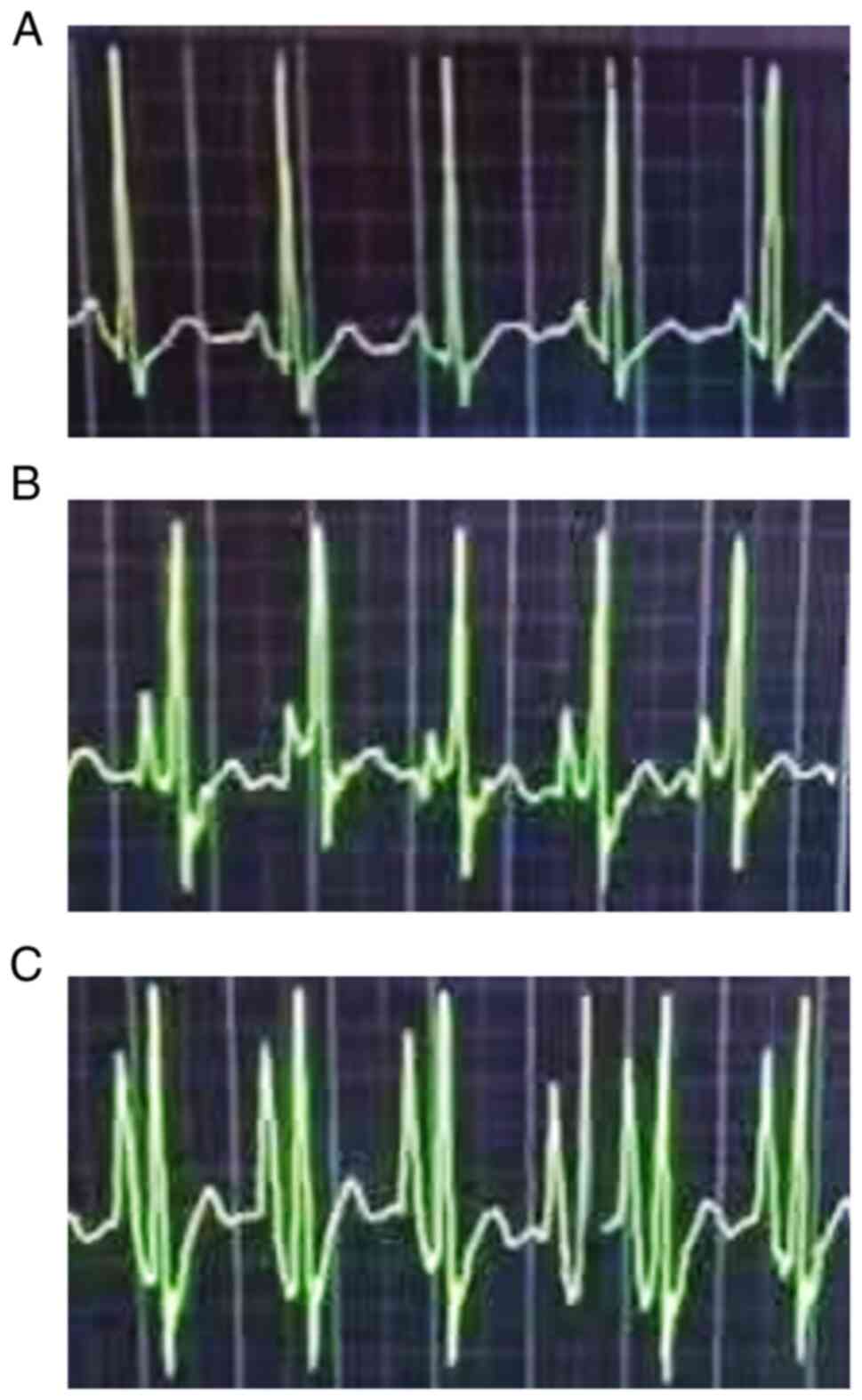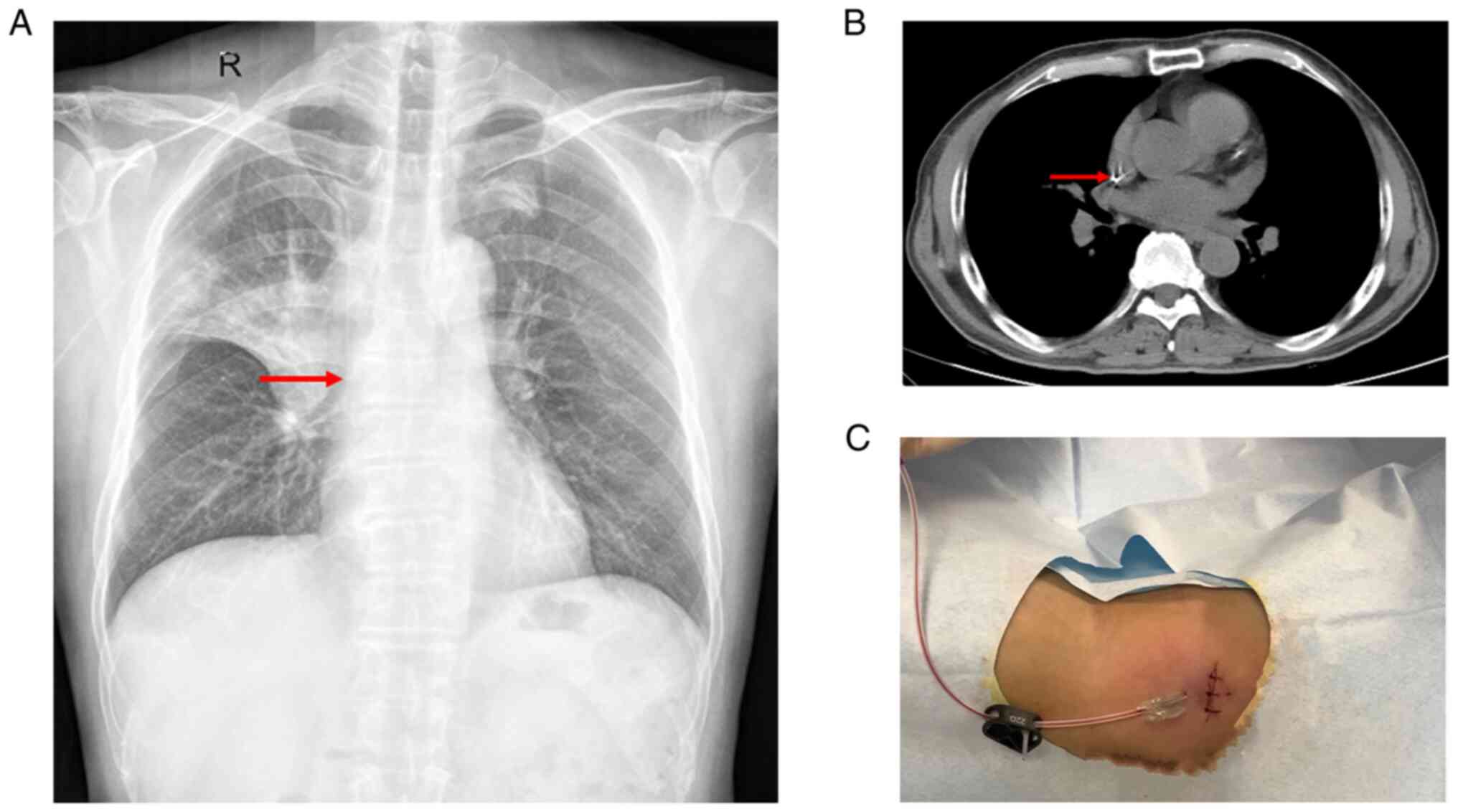|
1
|
Canfora A, Mauriello C, Ferronetti A,
Marte G, Di Maio V, Ciorra G, Esposito MG, Giuliano ME, Fregola G,
Barra L, et al: Efficacy and safety of ultrasound-guided placement
of central venous port systems via the right internal jugular vein
in elderly oncologic patients: Our single-center experience and
protocol. Aging Clin Exp Res. 29 (Suppl 1):S127–S130.
2017.PubMed/NCBI View Article : Google Scholar
|
|
2
|
Bow EJ, Kilpatrick MG and Clinch JJ:
Totally implantable venous access ports systems for patients
receiving chemotherapy for solid tissue malignancies: A randomized
controlled clinical trial examining the safety, efficacy, costs,
and impact on quality of life. J Clin Oncol.
17(1267)1999.PubMed/NCBI View Article : Google Scholar
|
|
3
|
Klaiber U, Probst P, Hackbusch M, Jensen
K, Dörr-Harim C, Hüttner FJ, Hackert T, Diener MK, Büchler MW and
Knebel P: Meta-analysis of primary open versus closed cannulation
strategy for totally implantable venous access port implantation.
Langenbecks Arch Surg. 406:587–596. 2021.PubMed/NCBI View Article : Google Scholar
|
|
4
|
Pinelli F, Cecero E, Degl'Innocenti D,
Selmi V, Giua R, Villa G, Chelazzi C, Romagnoli S and Pittiruti M:
Infection of totally implantable venous access devices: A review of
the literature. J Vasc Access. 19:230–242. 2018.PubMed/NCBI View Article : Google Scholar
|
|
5
|
Dariushnia SR, Wallace MJ, Siddiqi NH,
Towbin RB, Wojak JC, Kundu S and Cardella JF: Society of
Interventional Radiology Standards of Practice Committee. Quality
improvement guidelines for central venous access. J Vasc Interv
Radiol. 21:976–981. 2010.PubMed/NCBI View Article : Google Scholar
|
|
6
|
Kurul S, Saip P and Aydin T: Totally
implantable venous-access ports: Local problems and extravasation
injury. Lancet Oncol. 3:684–692. 2002.PubMed/NCBI View Article : Google Scholar
|
|
7
|
Minichsdorfer C, Füreder T, Mähr B,
Berghoff AS, Heynar H, Dressler A, Gnant M, Zielinski C and Bartsch
R: A cross-sectional study of patients' satisfaction with totally
implanted access ports. Clin J Oncol Nurs. 20:175–180.
2016.PubMed/NCBI View Article : Google Scholar
|
|
8
|
Sun X, Bai X, Shen J, Yu Z, Zhuang Z and
Jin Y: Comparison between ultrasound-guided TIVAD via the right
innominate vein and the right internal jugular vein approach. BMC
Surg. 19(189)2019.PubMed/NCBI View Article : Google Scholar
|
|
9
|
Tabatabaie O, Kasumova GG, Eskander MF,
Critchlow JF, Tawa NE and Tseng JF: Totally implantable venous
access devices: A review of complications and management
strategies. Am J Clin Oncol. 40:94–105. 2017.PubMed/NCBI View Article : Google Scholar
|
|
10
|
Gonda SJ and Li R: Principles of
subcutaneous port placement. Tech Vasc Interv Radiol. 14:198–203.
2011.PubMed/NCBI View Article : Google Scholar
|
|
11
|
Tippit D, Siegel E, Ochoa D, Pennisi A,
Hill E, Merrill A, Rowe M, Henry-Tillman R, Ananthula A and Makhoul
I: Upper-extremity deep vein thrombosis in patients with breast
cancer with chest versus arm central venous port catheters. Breast
Cancer (Auckl). 12(1178223418771909)2018.PubMed/NCBI View Article : Google Scholar
|
|
12
|
Zhou C, Lu L, Yang L, Xi W, Ma T, Yang C,
Wu J, Shangguan C, Zhu Z and Zhang J: Modified surface measurement
method to determine catheter tip position of totally implantable
venous access port through right subclavian vein. J Vasc Surg
Venous Lymphat Disord. 9:409–415. 2021.PubMed/NCBI View Article : Google Scholar
|
|
13
|
Liu G, Hou W, Zhou C, Yin Y, Lu S, Duan C,
Li M, Toft ES and Zhang H: Meta-analysis of intracavitary
electrocardiogram guidance for peripherally inserted central
catheter placement. J Vasc Access. 20:577–582. 2019.PubMed/NCBI View Article : Google Scholar
|
|
14
|
Yuan L, Li R, Meng A, Feng Y, Wu X, Yang
Y, Chen P, Qiu Z, Qi J, Chen C, et al: Superior success rate of
intracavitary electrocardiogram guidance for peripherally inserted
central catheter placement in patients with cancer: A randomized
open-label controlled multicenter study. PLoS One.
12(e0171630)2017.PubMed/NCBI View Article : Google Scholar
|
|
15
|
Cuschieri S: The STROBE guidelines. Saudi
J Anaesth. 13 (Suppl 1):S31–S34. 2019.PubMed/NCBI View Article : Google Scholar
|
|
16
|
Xu H, Chen R, Jiang C, You S, Zhu Q, Li Y,
Li S, Zha X and Wang J: Implanting totally implantable venous
access ports in the upper arm is feasible and safe for patients
with early breast cancer. J Vasc Access. 21:609–614.
2020.PubMed/NCBI View Article : Google Scholar
|
|
17
|
Akahane A, Sone M, Ehara S, Kato K, Tanaka
R and Nakasato T: Subclavian vein versus arm vein for totally
implantable central venous port for patients with head and neck
cancer: A retrospective comparative analysis. Cardiovasc Intervent
Radiol. 34:1222–1229. 2011.PubMed/NCBI View Article : Google Scholar
|
|
18
|
Hinck SM: Implementing the infusion
therapy standards of practice. Home Healthc Now.
39(295)2021.PubMed/NCBI View Article : Google Scholar
|
|
19
|
Gorski LA: The 2016 infusion therapy
standards of practice. Home Healthc Now. 35:10–18. 2017.PubMed/NCBI View Article : Google Scholar
|
|
20
|
Burbridge B and Goyal K: Quality-of-life
assessment: Arm TIVAD versus chest TIVAD. J Vasc Access.
17:527–534. 2016.PubMed/NCBI View Article : Google Scholar
|
|
21
|
Jheengut Y and Fan B: Intraoperative
identification of persistent left superior vena cava with
intracavitary electrocardiogram during venous port insertion: A
report of eight cases. J Vasc Access. 22:834–839. 2021.PubMed/NCBI View Article : Google Scholar
|
|
22
|
Sousa B, Furlanetto J, Hutka M, Gouveia P,
Wuerstlein R, Mariz JM, Pinto D and Cardoso F: ESMO Guidelines
Committee. Central venous access in oncology: ESMO clinical
practice guidelines. Ann Oncol. 26 (Suppl 5):v152–v168.
2015.PubMed/NCBI View Article : Google Scholar
|
|
23
|
Li J, Chen W, Zhao W, Zhang H, Huang Z,
Zhang S and Li Y: Surface measurement, intracardiac
electrocardiogram and tracheal bifurcation techniques for locating
the catheter tips of totally implantable venous access port. Comput
Methods Programs Biomed. 187(105238)2020.PubMed/NCBI View Article : Google Scholar
|
|
24
|
Rosche N and Stehr W: Evaluation of a
magnetic tracking and electrocardiogram-based tip confirmation
system for peripherally inserted central catheters in pediatric
patients. J Infus Nurs. 41:301–308. 2018.PubMed/NCBI View Article : Google Scholar
|
|
25
|
Bertoglio S, Annetta MG, Brescia F, Emoli
A, Fabiani F, Fino M, Merlicco D, Musaro A, Orlandi M, Parisella L,
et al: A multicenter retrospective study on 4480 implanted
PICC-ports: A GAVeCeLT project. J Vasc Access: 11297298211067683,
Jan 17, 2022. (Epub ahead of print).
|
|
26
|
Bloemen A, Daniels AM, Samyn MG, Janssen
RJ and Elshof JW: Electrocardiographic-guided tip positioning
technique for peripherally inserted central catheters in a Dutch
teaching hospital: Feasibility and cost-effectiveness analysis in a
prospective cohort study. J Vasc Access. 19:578–584.
2018.PubMed/NCBI View Article : Google Scholar
|
|
27
|
Walker G, Chan RJ, Alexandrou E, Webster J
and Rickard C: Effectiveness of electrocardiographic guidance in
CVAD tip placement. Br J Nurs. 24:S4, S6. S8–S12. 2015.PubMed/NCBI View Article : Google Scholar
|
|
28
|
Jonczyk M, Gebauer B, Rotzinger R,
Schnapauff D, Hamm B and Collettini F: Totally implantable central
venous port catheters: Radiation exposure as a function of puncture
site and operator experience. In vivo. 32:179–184. 2018.PubMed/NCBI View Article : Google Scholar
|
|
29
|
Gurkan S, Seber S, Gur O, Yetisyigit T,
Okan Donbaloglu M and Ozkaramanli Gur D: Retrospective evaluation
of totally implantable venous access port devices: Early and late
complications. J BUON. 20:338–345. 2015.PubMed/NCBI
|
|
30
|
Li A, Jiao J, Zhang Y, Tian L, Miao J, Hao
X, Sun Z and Sun Q: A randomized controlled study of bedside
electrocardiograph-guided tip location technique & the
traditional chest radiography tip location technique for
peripherally inserted central venous catheter in cancer patients.
Indian J Med Res. 147:477–483. 2018.PubMed/NCBI View Article : Google Scholar
|
|
31
|
Bertoglio S, Cafiero F, Meszaros P,
Varaldo E, Blondeaux E, Molinelli C and Minuto M: PICC-PORT totally
implantable vascular access device in breast cancer patients
undergoing chemotherapy. J Vasc Access. 21:460–466. 2020.PubMed/NCBI View Article : Google Scholar
|
















